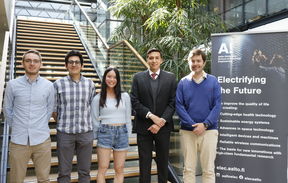Aalto's students' project work utilises LEDs and smartphones for indoor navigation

A group of Communications Engineering master's students designed a system that sends positioning information and allows a comfortable experience in unfamiliar indoor locations. They made the project in the course Special Project in Communications Engineering, where students were tasked to plan an RDI project taking advantage of the technical knowledge acquired during their Master’s studies.
In the system, they used Visible Light Communication (VLC) where LEDs used for indoor illumination will transmit exact coordinates where the person is located.
The task wasn't easy, but students really enjoyed working with the project.
'Besides the obtained and implemented knowledge in the area of communications engineering, the fact of tackling a futuristic technological challenge with an international team, is definitely one of the best things of project-based working; the knowledge and moments shared with my teammates and supervisor will be unforgettable,' says Josué Magaña Moreno, one of the students in the project.
The project addresses an actual need
People face problems with indoor localisation daily in places like malls, university buildings and supermarkets. Commonly used tool, GPS, works well in outdoors but it is not an accurate tool for indoor positioning.
VLC technology can offer a solution to this problem. It can be used in indoor localisation, and VLC can also reuse energy and use LEDs and smartphones as VLC transmitters and receivers.
This was the idea behind the students' project. In their project, person's position indoors is identified by pointing the camera of the mobile phone to the nearest light. This is similar to QR-code scanner, but instead of scanning the QR-code, you scan the light. The information about the localisation is embedded into the intensity modulation of the LED light, which should ideally be imperceptible to the human eye. If you want to know more about the technical side of the project, please see the students' video below.
Research Fellow Alexis Dowhuszko, who was one of the supervisors in the course, was really impressed about the students' work.
'The project covered all the phases needed to create a start-up. It started from an idea based on an actual need, and finished with a complete proof-of-concept', he says.
Success comes from failure
For the team, the project was the first step to be more aware and broadening their knowledge in VLC technology. It allowed them to see the potential and future applications that can improve and solve local and global issues.
Student César Olvera Espinosa thinks that one of the great things about learning is stumbling upon something you do not understand.
'I had heard about VLC in some courses, and it was satisfying to apply this concept to indoor localisation, learn in more detail how it works, and what it entails.'
The students showed strong problem-solving skills once the problem was clearly defined.
'We learned that success comes from failure. It's often necessary to be faced with roadblocks in the process of achieving a goal. However, the important thing is to persevere and trust the process, brainstorming alternatives to combat the issue,' says a student Beverley Goh.
All the team members have a lot ideas for the future development.
'Making use of the rolling shutter effect would allow us to increase the data rate significantly. Additionally, the computer vision algorithm can be extended to allow a changing position of the receiver during operation. Last, transferring the VLC receiver components (camera and algorithm) into a mobile phone would allow for the integration of this communication technology into people’s everyday life,' says student David Rombach.
Read more news

Are you tired of bad news?
The Laboratory of Hope exhibition presents ideas for a brighter future from 5th February to 27th March 2026
UniSport services at Aalto University in spring 2026
Group excericise classes and free break excercise for students and staff at Aalto University.Apply to be a guest professor or visiting researcher at the Université Grenoble Alpes
Unite! partner, Université Grenoble Alpes (UGA) has opened a call to host international professors and researchers for short stays.






